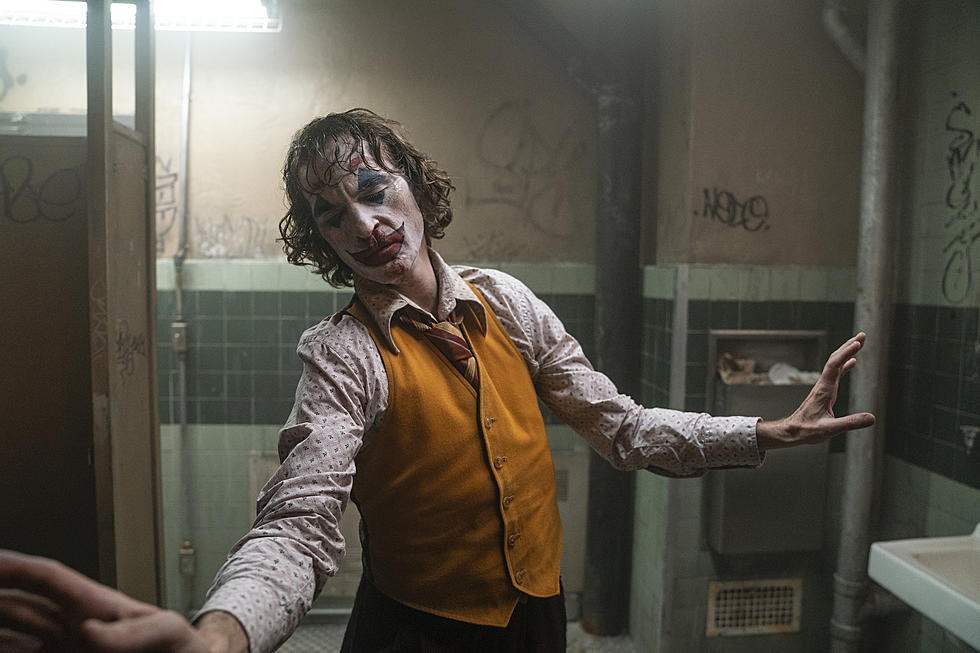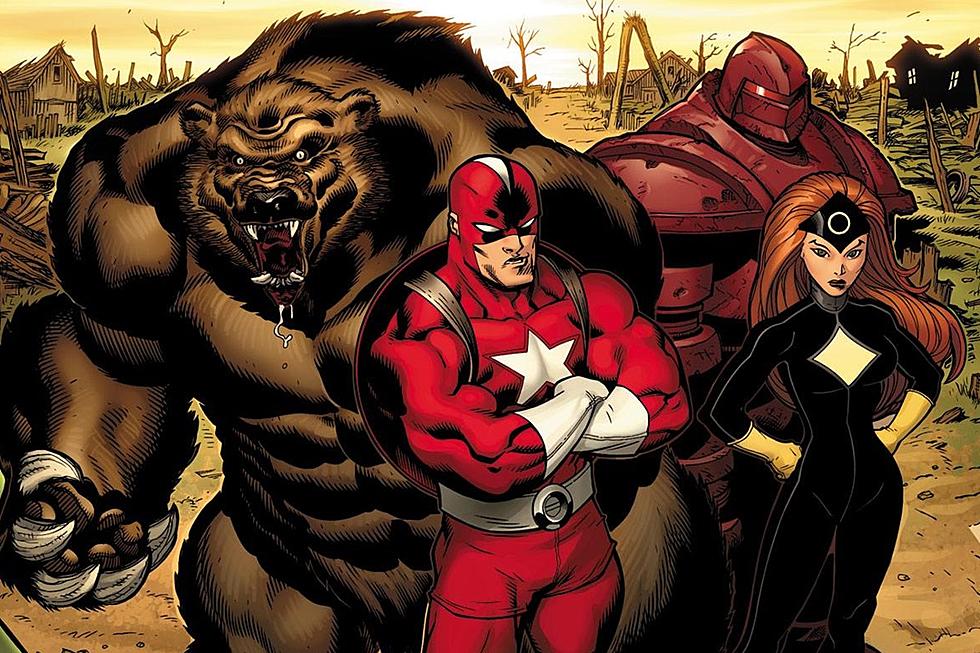![‘Masters of Comic Book Art’ Documentary Reemerges from the VHS Ether [Video]](http://townsquare.media/site/622/files/2012/02/untitled-2-1330485123.jpg?w=980&q=75)
‘Masters of Comic Book Art’ Documentary Reemerges from the VHS Ether [Video]

Presented by an uncharacteristically reverent Harlan Ellison, Masters of Comic Book Art is a documentary film that offers insightful on-camera remarks from some of the medium's most gifted artists: Neal Adams, Steve Ditko, Will Eisner, Jean Giraud aka Moebius, Jack Kirby, Harvey Kurtzman, Frank Miller and Bernie Wrightson, all of whom muse on their most famous works and the medium that they love. Released on video in 1987, the film is something I'd always heard about but had never seen until it reappeared on YouTube earlier this week. It's especially interesting to listen to the creators who are no longer with us and those, like Cerebus' Sim and Holy Terror's Miller, whose work subsequent to this film had a strong impact on how their audience related to them.
Some highlights:
- Ellison introduced comics as one of the five native American art forms that also includes banjo music, jazz music, musical comedy, and the mystery story as innovated by Edgar Allan Poe.
- Ellison described The Spirit creator and graphic novel innovator Will Eisner as the O. Henry of comics and a talent that "appears once every hundred years."
- Eisner said "comics" is a misnomer, and that the medium is more properly expressed as "sequential art." He said, "This is a valid medium of expression, equal in respectability, if you will, to words without pictures or to film."
- Eisner compared his work to music. "Each page has a rhythm. I deal in timing."
- Eisner also compared his work to theatre. "I think of a panel as a stage with a proscenium arch. I arrange my figures in a panel as a director would arrange actors on a stage."
- Eisner learned from depression era theatre that an "enormous amount of storytelling can be suggested by lighting."
- Ellison called Harvey Kurtzman "the father of the underground comic" and an "outstanding social critic on par with HL Mencken, Will Rogers and Thomas Nast." He said Kurtzman's work in MAD and elsewhere "Makes us laugh till it hurts and, more urgently, makes us think till it hurts."
- In a moment that you really have to see for yourself, Kurtzman describes the nature of a joke.
- The original Marvel Comics architect, Jack Kirby, on his process: "I see the story first. I know those people first. When I put them down on paper, they've already lived. My stories are very sincere. My stories are people stories."
- Kirby said his inspiration for innovating superhero comics in the 1960s was simply, "I had to make sales. I had to come up with characters that were no longer stereotypes. I couldn't depend on gangsters, I had to do something new."
- Kirby on his cosmology: "For some reason I went to the Bible and came up with Galactus. There I was in front of this tremendous figure who I knew very well because I always felt him. I couldn't treat him the way I would any other mortal. And of course the Silver Surfer is the fallen angel." He continued, "The New Gods evolved from those mythical lines. Everybody else had their gods, so what are ours? What is the shape of our society in the form of myths and legends? Who are our evil gods and who are our good ones? I tried to resolve that in the New Gods." Kirby concluded, "I didn't resolve the questions. I say, What's out there? and I try to resolve that. I never can."
- Spider-Man and Doctor Strange co-creator Steve Ditko is the only participant who doesn't appear on camera, but he offered an audio recording of a statement concerning his comic book character Mr. A. and its roots in the philosophies of Ayn Rand and Aristotle. It's a protracted speech that is deeply fascinating but doubtlessly objectionable to some people. The following is a passage that references comic book superheroes specifically:
"Early comicbook heroes were not about life as it is, but creations of how a man with a clear understanding of right and wrong, and more courage, chose to act - even if branded an outlaw. He dispensed a better justice than pervading legal, moral one. He was a moral avenger. He was not like everyone else. Not the average, the common or the ordinary man. He was the exceptional one. The uncommon one. The one doing what others were unwilling to do, regardless of the opposition and the consequences to himself. His success provided a better model. Through a hero, one could identify the foolish, the corrupt and the guilty.
"A lead character can be better or worse than society's best model. And if a man with proven better qualities appears, then a new measuring standard for men, and society, is established. A hero is a model for everyone. But not everyone is willing to act at his best. A less demanding model blending good and bad is more comforting, easier to accept. For the self-flawed, an anti-hero provides a heroic label without the need to act better. A crooked cop, a flawed cop, is not a valid model of a good law enforcer. An anti-cop corrupts the legal good, an anti-hero corrupts the moral good. Both corrupt ideals. Both choose the flaw over the perfect.
"The perfect is identified and measured by what is possible to man. A perfect bowling score. A perfect response accepts the truth and rejects the lie. The perfect hero, on principle, says yes to a true identity and no to a contradictory one. Ruled by justice, he treats every identity as it deserves. He is the actualized potential for good in its purest form. A true moral measuring ruler. He is the most human and deserving of respect. Today's flawed superheroes are superior in physical strength but common, average, ordinary in mental strength - rich in superpowers, but bankrupt in reasoning powers. They are perfect in overcoming the flawed supervillains, saving the world, the universe!, yet helpless to solve their common, average, ordinary personal problems. It is like creating a perfectly physical adult with the reasoning limits of a six-year-old."
- Ellison characterized Neal Adams' contributions to comics as bringing "realism and believability to the superhero genre" with a combination of "photorealism and dynamic action," specifically in the pages of Deadman and his "astonishing work" with Denny O'Neil in Green Lantern/Green Arrow.
- Adams discussed the distinction between a comic strip and a comic book: "Deadman was an opportunity to experiment with page format and layout. I got a little radical on it. I was totally rambunctious and out of order," he said. "I could do anything between one drawing and ten drawings on a page. I felt that I could lead the eye, that I could catch the reader and make him read the way I wanted him to read. I could make him stop when I wanted him to stop. I could become one with the reader."
- Ellison said Adams "Rescued the Batman from the swamp of television camp to which the Batman had sunk." Adams discussed his work with the character, saying, "Batman was originally created by Bob Kane and Bill Finger and Jerry Robinson as this creature of the night... that's what I tried to return him to. One could say that Frank Miller working on Batman now has done more to make Batman a more solid character. At that time, what I did was bring him back to what he was supposed to be. Now people are playing with it within that framework and, I think, doing a very good job."
- Ellison described Swamp Thing co-creator Bernie Wrightson as "master of the macabre." The artist described his process: "What always comes first is a picture in my mind. I always see something very definitely. I always see it exactly the way I draw it. The finished product is almost always like I had an opaque projector in my head, projecting out through my eyes, and all I do is trace what I see."
- The Incal and Arzach creator Moebius said he turned to comics as a way to escape the homogenous world of commercial art. "Comics gives to the artist a very interesting field of exploration and research. Everything is possible. You can be very small or very big or very modest or very ambitious. You can stay in a regular style like everybody or you can escape and be completely unusual and incredible. You can give more to the world, more to the drawing... everything."
- The Dark Knight Returns and Ronin cartoonist Frank Miller discussed the nature of the cartoonist versus the writer-artist team. "In the '40s when comics started really taking off... the outstanding comics had generally been done by one person who writes and draws, Will Eisner being the preeminent example. I believe it is one art. However, I don't believe that it's the only way it can be done. My collaborations... have taught me that thrilling things happen when another artist is at work, when you're playing off somebody, when you get those surprises and when you get those problems to solve."
- Cerebus creator Dave Sim talked about his compulsion to infuse entertainment with more humanity. "If you make something your life's work, you're going to find a way to put everything that's important to you into it in one regard or another... It's two people in a room. For years 'talking heads' was a pejorative. I think David Byrne has helped a great deal in establishing, 'Hey that's what it is.' If you're going to do a film or a comic book that doesn't have two people talking, that's missing the essence of what's human. We are human because we sit and talk. How many fist fights does the average person get into in their lifetime? How many people go flying off their balcony? How many people get in a car chase? [These] things become cliches in entertainment and [are] virtually nonexistent in real life. What makes that art, then? Art is supposed to be something that speaks to the human condition. You see very little of what speaks to the human condition in most popular culture."
- Ellison introduced Art Spiegelman by pointing out that his holocaust graphic novel Maus "drew attention to comics from people who would otherwise not read anything in comics."
- Spiegelman shared his estimation of the comics medium: "Since all we're talking about is words and pictures plastered together somehow... a structure is made of those words and pictures and that can contain a comics equivalent to a Beethoven or a comics equivalent to a Van Halen. It's open. All it really is is a medium and then it becomes as strong or as potent as the artists within it."
- Spiegelman talked about where he would like to see the comics scene of 1987 go from there: "I'd like to see it move away from genre fiction. I'd like to see it move away from obsessive recapitulation of the same fantasies over and over again. I'd like to see subject matter more reflective of what people's actual situations are. I'd like to see it grapple with more difficult moral and political issues. I'd like to see it deal with more personal issues throughout. I'd like to see it develop aesthetically. I'd like to see people whose backgrounds aren't drawn solely from comic books. [I don't want to see something] that can be spit back is more comic books, third and fourth and fifth generation comic book vision. [I want to see] something that has its roots more in reality, both inner and outer."
The kind individual who uploaded Masters of Comic Book art has also gifted the Web with numerous other comic book documentaries, some of which are not otherwise available. Check them out at this link.
More From ComicsAlliance









